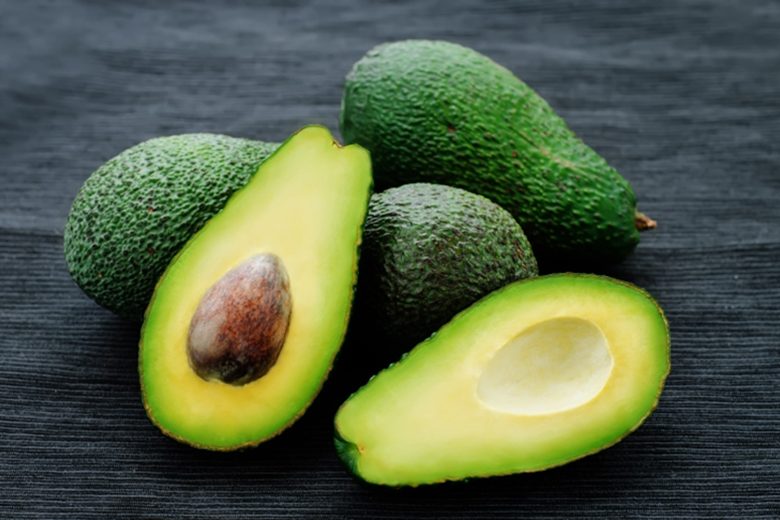
Health Benefits of Avocado
By Kerry Neville, MS, RD
Once shunned for high fat and calorie contents compared to other fruits, avocado’s nutritional reputation is on the upswing. One ounce (or about a fifth of a medium Hass avocado) has approximately 5 grams of fat—mostly monounsaturated fat. Clinical evidence is limited, but several studies examining the effects of diets high in monounsaturated fatty acids with avocados as a main source have found favorable results. Research suggests that avocados may help improve blood lipid profiles, benefit weight loss and—as a partial replacement for carbohydrates among people with non-insulin dependent diabetes—improve lipid profiles and help maintain glycemic control, too.
Avocados are particularly favorable as a substitute for spreads. Compared to an equal amount of butter or mayonnaise, two tablespoons of avocado contributes significantly less fat (5 grams vs. 23 grams in butter and 9 grams in mayo) and calories (50 calories vs. 204 calories in butter and 109 calories in mayo). Its saturated fat and sodium contribution is lower than that of butter or mayo, too—and since avocados are a fruit, they have vitamins, minerals and other plant compounds not found in butter or mayonnaise.
Along with folate, potassium, vitamins C, E and K, and fiber, avocados also contain phytonutrients. Several carotenoids are found in avocados, including alpha-carotene, beta-carotene, zeaxanthin and lutein. Lutein may benefit eye health by lowering risk of age-related macular degeneration, a leading cause of vision loss among Americans aged 60 and older.
People with renal diseases, nephrotic syndrome or pancreatitis may need to limit potassium intake. On the other hand, patients taking non-potassium-sparing diuretics who develop lower levels of potassium can incorporate avocados as part of a potassium-rich diet.
Avocado in the Kitchen
By Diane Quagliani, MBA, RD
Nicknamed the “alligator pear” because of its shape and green skin, most avocados sold in the U.S. are grown in California with some cropping up from Florida, Mexico and Chile. There are nearly 500 avocado varieties, but the pebbly-skinned Hass is most common and available year-round. The smooth-skinned Fuerte is found late fall through spring. Avocado flesh offers a buttery texture, rich nutty flavor and ranges from pale green to golden-green, depending on the variety of fruit.
Pick avocados that are firm, heavy for their size and without bruises or soft spots. Avocados are ripe when still firm but yield to gentle pressure. Hass avocados give an additional clue: the skin turns from green to near-black when ripe. Store avocados at room temperature or in a brown paper bag to ripen. To speed-ripen, add an apple or banana in the bag. To peel, cut a washed, ripe avocado lengthwise around the seed. Twist the halves to separate. Use a spoon to gently lift out the seed. Place the fruit cut-side down and peel back the skin with a knife or your fingers, or scoop out the flesh with a spoon. Store ripe, uncut avocados in the refrigerator up to three days. To store cut fruit, cover tightly with plastic wrap and refrigerate, or sprinkle with lemon juice and refrigerate in an air-tight container. To freeze, puree or mash the flesh with lemon juice (one tablespoon for two avocados) and place in a sealable freezer bag or airtight container. Freeze for up to five months.
If you have only used avocados in guacamole, get adventurous with this creamy, dreamy fruit. Try it diced in salads and salsas or sliced in omelets. Spread it mashed on sandwiches or burgers in place of mayo, or whirl it into smoothies. Or, do as the Brazilians do—add avocados to ice cream!
Using Avocado in Food Service
By Veronica McLymont, RD
As in the consumer market, Hass avocados are the most common offered by suppliers. But cost, the delicate nature of avocados and preparation time needed to peel, seed and prepare them are just a few of the reasons that many food service operators shy away from using fresh avocados, except for special events.
Most food service operations use prepared avocados that are either refrigerated or frozen. These products eliminate concern over ripening time and potential quality issues of using fresh avocados, plus they reduce preparation time. In addition, their longer shelf life (upwards of 18 months for frozen and 1_ months for refrigerated) can make avocado-enhanced menu items anytime options.
Refrigerated avocados are available as pulp or guacamole. Frozen avocados are available in halves, slices, dices and pulp, or as pre-made guacamole. Once thawed, frozen avocados last between one and three days. Frozen avocados should be thawed in the cooler or, if time is limited, the bag can be placed in a bowl of cold running water. Frozen and refrigerated prepared avocados tend to resist browning better than their fresh counterparts, thanks to citric acid solutions that are often added to the product. So give a little zest to your menu by adding avocado to sandwiches, wraps, salads, steaks and burgers.
